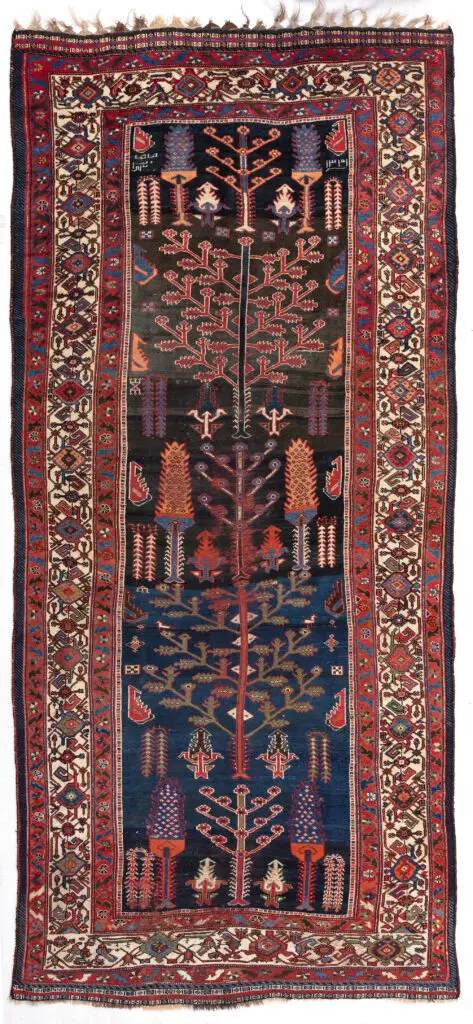Tree worship: Sacred Trees and Wishing Trees
Kurdish Tree Cult
“In various cultures and mythologies around the world, nature in its multifaceted forms, including trees, rivers, or mountains, are considered sacred and believed to embody deities, spirits, or even the souls of ancestors. Such beliefs are also found in Kurdish culture and mythology, which attribute spiritual or supernatural qualities to all natural objects, including stones, water, plants, and animals. (…) in present-day Kurdistan from late antiquity to modern times, along with other recurrent constituents (i.e., sacred mountains, healing sources, natural caves), the sacred tree was part of the local religious complex and its sacred landscape. The popular beliefs and practices associated with sacred trees persisted in this region until the current era, especially within native religious traditions (i.e., Yazidism or Yarsanism) (Terrebili 2017). T. F. Aristova points out that until fairly recently many Muslim rites and beliefs among Kurds coexisted with pre-Islamic cults associated with lakes, stones, graves, trees, fire, and an ancestor cult. (Aristova 1994, 226)’.” (Mustafa 2023)
Three kinds of sacred trees could be distinguished in Kurdish mythology and religious beliefs. First, a tree god called Yazd, whose worship had survived until the early 20th century, although not necessarily as an organised religion. The tree that Yazd believed to be inhabited was regarded as the King of the Forest. The trees or bushes that enclosed the sacred tree were highly revered, for they were regarded as the Children of Yazd.
The second type of sacred trees is considered the abode of spirits, lending them their supernatural attributes. These tree spirits may be ancestral beings, jinns, demons (dews) and other supernatural entities. They are seen as guardians, protectors, sources of wisdom and guidance. This is best evident in rituals associated with the tree pīrs and Dārī Mirāzān/ Dārā Mirāzā. The third type of sacred tree is the Tree of Life. (Mustafa 2023)
Wishing Trees
A wishing tree, also known as a votive tree, is a single tree that often stands in a sacred place and has supernatural powers. Anyone who hangs a strip of cloth or similar item from their possessions on the tree hopes that this will make a wish come true. The offering can also be a votive gift in gratitude for a miracle that has already happened. Depending on the respective folk belief, which can occur in principle in all religions, the wish-fulfilling powers are spirits, fairies, saints, or deities. In folk Islam, wishing trees can be found from Morocco to Turkey (dilek-ağaçları) and Pakistan to Indonesia. Wishing trees are often located at a special place, such as a holy spring, a church or chapel, or an Islamic shrine.
Dārī Mirāzān: ‘The Tree of Wishes’
Wishing trees are a universal belief, which is also known to all cultures of Dersim. These trees are often located near sacred springs or rivers and are affiliated with water and fertility cults.
One of the manifestations of the tree worship in Kurdish culture is the Dārī Mirāzān or Dārā Mirāzā, “The Tree of Wishes.” (Mustafa 2023) Women would visit these trees believing that such visits could bestow blessings on barren women and help them get pregnant. Others visited them believing that they had spiritual or physical healing powers. Or anyone who wished for their desires to be fulfilled would resort to the tree of wishes. They would tie a piece of personal cloth onto the tree, with the idea that now the person has tied a part of themselves onto the tree for blessing or healing. Those struggling with illnesses would tie a rag on the tree, believing that they had attached their pain to the tree. At the same time they would make a request and vow that they will perform some meritorious act if the request is granted. (Hansen 1961, 162)
The tree of wishes is believed to be the abode of spirits, jinns, or dēws (demons) who are associated with fertility, guidance, power, and protection – as well as bad luck and misfortune. The veneration of the trees is, therefore, often accompanied by sacrifices to the spirits under the trees as votive offerings or to ward off evil forces and bad luck. These trees are either single units or groves, their sacred character depends on their location (sacred places), size, and age, rather than the type of tree species.
Henry Harald Hansen describes a type of tree of wishes adorned not only by rags, but also by a ram’s horn, with a wooden holy hand set up beside it, stood inside the grating that protected a sacred grave. (Hansen 1961, 158-160) The holy hand was probably Hamsa (meaning “five” in Arabic), a symbolic hand which represents protection in both Jewish and Islamic cultures. In Islamic tradition, it symbolizes the “hand of Fāṭimah”, the daughter of the Prophet Muḥammad.
In some areas, nails are hammered into a sacred tree to transfer pain or illness into the tree. These types of wishing trees are called Dāra Bizmār ‘Nail Tree’ in Kurdish. Hammering nails and hanging clothes are “tying” rituals, whereby the person seeks healing or a solution to problems by transferring his or her illness or problems onto the tree (Dafni 2007, 9).
Rain rituals are also often performed around the tree of wishes. In Silemani and Kirkuk, Thomas Bois describes one example of magical rites in which the Kurds engaged to bring rain or, on the other hand, to cause it to cease: “The women, having donned their finest clothes, go together in a band into the country to an ancient and venerable tree in the shade of which they install themselves. Having taken with them the necessary kitchen utensils and provisions, they dance around the saucepan until the meal is ready. After the meal, they pour water over the prettiest dress of the company and await the rain. If no rain falls before it is time to return, they pour water over one another’s clothes and go back to their homes completely soaked.” (Bois 1966, 105)
World Tree and Tree of Life
The world tree is the universal mythological symbol of the world axis (axis mundi), the center of the world, or the Old Testament tree of life in paradise. In the creation story in the first book of Genesis, the tree of life is a tree in the heart of paradise that grants eternal life to those who eat its fruit. Adam and Eve are expelled from paradise so that they do not also eat from the tree of life after they have already eaten from the tree of knowledge. Their punishment for violating the prohibition was the loss of immortality.
According to Jewish mythology, the Garden of Eden contains the Tree of Life (etz chaim) or “Tree of Souls”, which blossoms and produces new souls. These souls fall into the Guf, the treasure trove of souls. The angel Gabriel reaches into the treasure trove and takes the first soul that falls into his hand. The fertility angel Leila then watches over the embryo until its birth.
The tree of life is a common symbol in Jewish, Islamic, and Christian art. In stylised form, it is very common in Armenian and Kurdish weaving. In Jewish and Islamic art, it often has seven branches, which correspond to the seven arms of the Jewish menorah, which in turn symbolise the seven days of creation.
In Islam, the mythical Tuba tree (‘bliss, blessedness’) is well known. Although it is not mentioned in the Quran, according to Hadith literature, it grows in (heavenly) paradise: ‘Those who believe and do good deeds are blessed’ (ṭūbā lahum). (Bobzin 2010, 216) According to tradition, the Tuba tree has branches made of emerald and pearls. Its crown is said to be so large that a rider could travel for a hundred years without crossing its shade, which is why it is said to be visible from the edges of paradise. Its trunk stands in the palace of the Prophet, its branches reaching into the homes of the faithful, who can thus feast on its delicious fruits.
The tree of life symbolises all that is good and useful, in contrast to the cursed tree Zaqqūm, the tree of hell and the antithesis of salvation, which is actually mentioned by name in the Quran as the food of sinners, among other things. The tuba tree symbolises paradise or the tree of paradise (tree of knowledge), just as the sidra tree symbolises the boundaries of the universe, and the lotus tree symbolises the boundaries of everything imaginable.
In Sufism, the tree symbolizes closeness to God and appears prominently, for example, in the work of the Iranian philosopher and mystic Suhrawardi, who equates it with the Simorgh (Simurgh) tree from Iranian mythology (Fischer 2004, 136). Tuba (Persian طوبا) is an Iranian female first name, also common in Turkey in the form Tuğba.
Endangered Faith
Alevis traditionally have strong beliefs rooted in nature veneration, seeing divine or semi-deific figures associated with natural objects and places. In Kurdish Alevi (Rêya Heqî, Raa Haqi) belief, trees are often considered sacred natural entities and sanctuaries, known as jiare, and are venerated alongside other natural elements like mountains and rivers. While specific rituals associated with trees may be fading due to cultural shifts, repressions and subsequent emigration and assimilation, historical accounts show Kurds tying offerings to sacred trees, seeking healing from their leaves, and even holding festivals under them. These practices reflect a broader tradition of nature veneration where divinity is believed to reside in or be associated with specific natural sites and objects.
Historical accounts indicate that non-Alevi groups, such as the Turkish authorities, viewed these tree veneration practices with suspicion, labeling them as acts of divine worship, notes the National Institutes of Health (NIH).
The trees of wishes are highly venerated in Kurdish culture. In Northern Kurdistan, the Turkish regime often cuts down sacred trees as a form of psychological warfare against the Kurds. Likewise, since Turkey’s occupation of Afrin in Rojava in 2018, as part of their ethnic cleansing campaigns against Kurds, Turkish-backed Syrian mercenaries have cut down over 1.5 million trees, (SCF 2021) including the trees of wishes that were over 100 years old (Omer 2022).
“The Turkish and Iranian regimes have for decades been destroying the nature of the Kurdish settlement areas, including many of the sacred trees, rivers, and springs, through the construction of dams, river diversions, and deforestation in order to eliminate the cultural memory of Kurds and their strong feelings of attachment to their land. In response to these attempts, we find within the Kurdish freedom movement a creative, revolutionary dialectic in which new meaning is infused into age-old nature-affirming values by contemporary social and ecological struggles. Ahmet Kerim Gültekin (2021, 225-42) quotes Bilgin’s observation that a ‘new understanding of nature is being forged in the Kurdish Alevis’ struggles against incursions by dam projects, mining companies, tourism policies, and other threats.’ As Gültekin notes, in these struggles, the Kurds’ confrontation with the long-standing threat of genocide is being expanded into a profound social ecological understanding of the threat to both the land and people posed by ecocide.” (Mustafa 2023)
Other scientists confirm the accusation of ecocide: “The neoliberal ecological destruction taking place in Dersim, as well as in other parts of Turkey’s Kurdistan, can be defined as deliberate and systematic ecological destruction, also referred to as a (neocolonial) ecocide. The genocidal and developmental policies of the past seem to have converged into an ecocidal extractivism, coupled with the destruction of people’s lifeworlds.” (Dinç 2025, 61)
Conclusion
The Dersim Alevis’ closed and ancient connection to nature made tree worship particularly intense in this region. Sacred trees play an important role in the religious practices of the Raa Haqis as wish or votive trees, and as trees of life. The latter are a frequent motif in the carpet-knotting art of Kurds. The Raa Haqis share their beliefs and rituals of this faith with Alevi, Christian and Zoroastrian Armenians, Yazidis, and Yarsanis (Ahl-e Haqqi community). The belief in sacred beings in nature also strengthened the Alevis’ connection to the land of Dersim.
In Dersim, the Turkish state’s fight against the Kurdish political actors took on religious characteristics by targeting the local tree worship. The frequent destruction of forests, sacred groves, and trees, as well as the illegal hunting of sacred bezoar goats, acquired the character of ecocide, i.e., the destruction of the indigenous population’s livelihoods and elements of their faith. As a result of displacement, emigration, and assimilation, scholars observed a decline in tree worship. At the same time, however, the ecocide revived the population’s resistance to the associated measures and strengthened the environmental movement in Dersim and its diaspora.
Arakelova, Victoria. 2020. “A Note on Tree Worship in the Zaza Folk Beliefs.” Iran and the Caucasus 24 (4): 405-410. https://www.researchgate.net/publication/347481105_A_Note_on_Tree_Worship_in_the_Zaza_Folk_Beliefs
Aristova, T. F. 1994. “Kurds.” In Encyclopedia of World Cultures, Vol. 6, Russia and Eurasia/China, edited by Paul Friedrich and Norma Diamond, 224-227. Boston: G. K. Hall & Co.
Bois, Thomas. 1966. The Kurds. Beirut: Khayats.
Dafni, Amots. 2007. “Rituals, Ceremonies and Customs Related to Sacred Trees with a Special Reference to the Middle East.” Journal of Ethnobiology and Ethnomedicine 3 (28).
Deniz, Dilşa. 2021. “The Philosophy of Ecology and Reya Heqi: Religion, Nature, and Femininity.” In Ecological Solidarity and the Kurdish Freedom Movement: Thought, Practice, Challenges and Opportunities, edited by Stephen E. Hunt, 242-260. Lanham, Boulder, London, New York: Lexington Books.
Dinç, Pınar. 2025. “Dersim: A Century of State-Led Destruction and Resistance.” In The Republic of Turkey and Its Unresolved Issues: 100 Years and Beyond, edited by Pınar Dinç and Olga Selin Hüler, 53-68. Cham: Palgrave Macmillan.
Fischer, Michael M. J. 2004. Mute Dreams, Blind Owls, and Dispersed Knowledges: Persian Poesis in the Transnational Circuitry. Durham: Duke University Press.
Gültekin, Ahmet Kerim. 2021. “Dersim as a Sacred Land: Contemporary Kurdish Alevi Ethno-Politics and Environmental Struggle.” In Ecological Solidarity and the Kurdish Freedom Movement: Thought, Practice, Challenges and Opportunities, edited by Stephen E. Hunt, 225-242. Lanham, Boulder, London, New York: Lexington Books.
Insom, Camilla, and Gianfilippo Terribili. 2021. “In the Shade of a Tree: Holy Figures and Prodigious Trees in Late-Antique and Medieval NW Iran and Adjacent Areas.” In Iranianate and Syriac Christianity in Late Antiquity and the Early Islamic Period (5th-11th Centuries), edited by Chiara Barbati and Vittorio Berti, 333-366. Publications on Iranian Studies 87. Vienna: Austrian Academy of Sciences Press.
Mustafa, Himdad. 2023. “Sacred Trees in Kurdish Culture & Mythology.” The Kurdish Center for Studies, June 26. https://nlka.net/eng/sacred-trees-in-kurdish-culture-mythology/#post-2511-footnote-1
Terribili, Gianfilippo. 2017. “In the Shade of a Tree: Religious Patterns in the Kurdistan Region from Late Antiquity to Modern Times.” Paper presented at the ASOR (American Society of Overseas Research) Annual Meeting, Boston.



